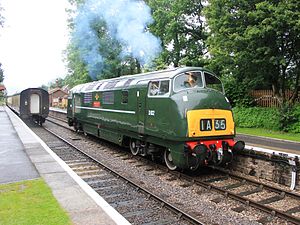Diesel-hydraulic railway locomotive used in Great Britain
| British Rail Class 42 Warship |
|---|
 |
|
|
| Performance figures |
|---|
| Maximum speed | 90 mph (145 km/h) |
|---|
| Power output | Engines: - 1,135 hp (846 kW) at 1,530 rpm x 2 (D803-29, D831-32 & D866-70)
- 1,035 hp (772 kW) at 1,400 rpm × 2 (D800 to 802)
- 1,200 hp (890 kW) at 1,500 rpm x 2 (D830)
|
|---|
| Tractive effort | Maximum: 48,200 lbf (214 kN) |
|---|
|
| Career |
|---|
| Operators | British Rail |
|---|
| Numbers | D800–D832, D866–D870 |
|---|
| Nicknames | Warships |
|---|
| Axle load class | Route availability 7 (RA 6 from 1969) |
|---|
| Retired | 1968–1972 |
|---|
| Preserved | - 821 Greyhound
- 832 Onslaught
|
|---|
| Scrapped | 1968–1972, 1985 (818 Glory) |
|---|
| Current owner | - Diesel Traction Group (821)
- Bury Hydraulic Group (832)
|
|---|
| Disposition | Two preserved, remainder scrapped |
|---|
|
The British Rail Class 42 Warship diesel-hydraulic locomotives were introduced in 1958. It was apparent at that time that the largest centre of expertise on diesel-hydraulic locomotives was in West Germany. The Western Region of British Railways negotiated a licence with German manufacturers to scale down the German Federal Railway's "V200" design to suit the smaller loading gauge of the British network, and to allow British manufacturers to construct the new locomotives. The resultant design bears a close resemblance, both cosmetically and in the engineering employed, to the original V200 design. Warship locomotives were divided into two batches: those built at BR's Swindon works were numbered in the series D800-D832 and D866-D870,[1] had a maximum tractive effort of 52,400 pounds-force (233,000 N) and eventually became British Rail Class 42. 33 others, D833–D865, were constructed by the North British Locomotive Company and became British Rail Class 43. They were allocated to Bristol Bath Road, Plymouth Laira, Newton Abbot and Old Oak Common.
Two Class 42s are preserved, D821 and D832.[2]
